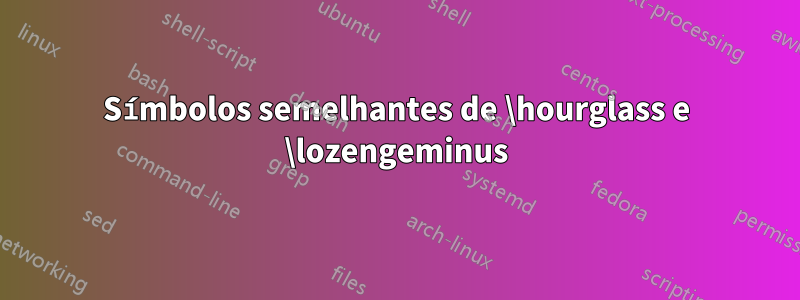
Existe uma maneira de obter símbolos semelhantes \hourglass(⧖) e \lozengeminus(⟠), ou seja, com triângulos idênticos?
Com ambos os pacotes fdsymbole stix, \lozengeminusé muito maior que o \hourglass.
O objetivo é ter dois operadores “opostos” com triângulos de baixo para cima e triângulos de cima para baixo, ou seja, o segundo sendo obtido pela troca dos triângulos.
Responder1
Talvez você possa definir a tikzpicturecomo um comando. Então você pode controlar o tamanho dos dois símbolos que deseja criar.
\documentclass{article}
\usepackage{tikz}
\newcommand{\hour}[1]{%
\begin{tikzpicture}
\draw (0,0) -- (6pt,0) -- (0,12pt) -- (6pt,12pt) -- (0,0);
\end{tikzpicture}
}
\newcommand{\loz}[1]{%
\begin{tikzpicture}
\draw (0,6pt) -- (3pt,12pt) -- (6pt,6pt);
\draw (0,6pt) -- (6pt,6pt);
\draw (0,6pt) -- (3pt,0) -- (6pt,6pt);
\end{tikzpicture}
}
\begin{document}
This is an example of \hour.
This is an example of \loz.
\end{document}
Essas definições específicas seriam assim:
Responder2
Outra opção é construí-lo a partir de duas cópias de \trianglewith stackengine.
\documentclass{article}
\usepackage{graphicx}
\usepackage{stackengine}
\begin{document}
$
\stackanchor[-4.1pt]{$\triangle$}{\rotatebox[origin=c]{180}{$\triangle$}}
\stackanchor[0pt]{\rotatebox[origin=c]{180}{$\triangle$}}{$\triangle$}
$
\end{document}
Responder3
Outra versão com picturemodo que se adapta aos estilos matemáticos. Modifique a largura/altura de acordo com seu gosto (mostrado com a largura definida como 0,33333em).
\documentclass{article}
\usepackage{amsmath}
\usepackage{pict2e}
\makeatletter
\newcommand{\lozengeminus}{%
\mathbin{% a binary operation symbol
\mspace{1mu}% some sidebearing
\mathpalette\vinc@lozengeminus\relax}% the symbol
\mspace{1mu}% some sidebearing
}
\newcommand{\vinc@lozengeminus}[2]{%
\begingroup
\settowidth{\unitlength}{$\m@th#1\mspace{6mu}$}% 1/3 of an em
\begin{picture}(1,1.732)
\vinc@linethickness{#1}
\roundcap\roundjoin
\Line(0.5,0)(1,0.866)(0.5,1.732)(0,0.866)(0.5,0)
\Line(0,0.866)(1,0.866)
\end{picture}%
\endgroup
}
\newcommand{\hourglass}{%
\mathbin{% a binary operation symbol
\mspace{1mu}% some sidebearing
\mathpalette\vinc@hourglass\relax}% the symbol
\mspace{1mu}% some sidebearing
}
\newcommand{\vinc@hourglass}[2]{%
\begingroup
\settowidth{\unitlength}{$\m@th#1\mspace{6mu}$}% 1/3 of an em
\begin{picture}(1,1.732)
\vinc@linethickness{#1}
\roundcap\roundjoin
\Line(0,0)(1,1.732)(0,1.732)(1,0)(0,0)
\end{picture}%
\endgroup
}
\newcommand{\vinc@linethickness}[1]{%
\linethickness{%
\ifx#1\displaystyle 0.8\fontdimen8\textfont3\else
\ifx#1\textstyle 0.8\fontdimen8\textfont3\else
\ifx#1\scriptstyle0.8\fontdimen8\scriptfont3\else
1\fontdimen8\scriptscriptfont3\fi\fi\fi
}%
}
\makeatother
\begin{document}
$x+a\lozengeminus b$
$\scriptstyle x+a\lozengeminus b$
$\scriptscriptstyle x+a\lozengeminus b$
$x+a\hourglass b$
$\scriptstyle x+a\hourglass b$
$\scriptscriptstyle x+a\hourglass b$
\end{document}
Responder4
O pacote oplotsymblfornece \rhombuslineho que pode estar próximo do que você deseja.
\documentclass{article}
\usepackage{stix}
\usepackage{oplotsymbl}
\begin{document}
$\hourglass \rhombuslineh$
\end{document}





